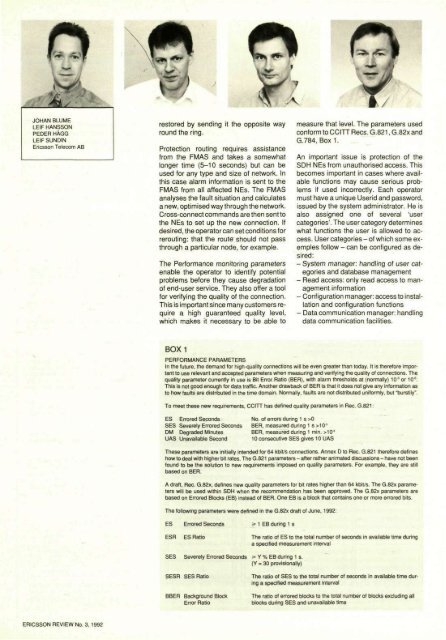An Introduction to the Ericsson Transport Network Architecture ...
An Introduction to the Ericsson Transport Network Architecture ...
An Introduction to the Ericsson Transport Network Architecture ...
You also want an ePaper? Increase the reach of your titles
YUMPU automatically turns print PDFs into web optimized ePapers that Google loves.
JOHAN BLUME<br />
LEIF HANSSON<br />
PEDER HAGG<br />
LEIF SUNDIN<br />
<strong>Ericsson</strong> Telecom AB<br />
res<strong>to</strong>red by sending it <strong>the</strong> opposite way<br />
round <strong>the</strong> ring.<br />
Protection routing requires assistance<br />
from <strong>the</strong> FMAS and takes a somewhat<br />
longer time (5-10 seconds) but can be<br />
used for any type and size of network. In<br />
this case alarm information is sent <strong>to</strong> <strong>the</strong><br />
FMAS from all affected NEs. The FMAS<br />
analyses <strong>the</strong> fault situation and calculates<br />
a new, optimised way through <strong>the</strong> network.<br />
Cross-connect commands are <strong>the</strong>n sent <strong>to</strong><br />
<strong>the</strong> NEs <strong>to</strong> set up <strong>the</strong> new connection. If<br />
desired, <strong>the</strong> opera<strong>to</strong>r can set conditions for<br />
rerouting: that <strong>the</strong> route should not pass<br />
through a particular node, for example.<br />
The Performance moni<strong>to</strong>ring parameters<br />
enable <strong>the</strong> opera<strong>to</strong>r <strong>to</strong> identify potential<br />
problems before <strong>the</strong>y cause degradation<br />
of end-user service. They also offer a <strong>to</strong>ol<br />
for verifying <strong>the</strong> quality of <strong>the</strong> connection.<br />
This is important since many cus<strong>to</strong>mers require<br />
a high guaranteed quality level,<br />
which makes it necessary <strong>to</strong> be able <strong>to</strong><br />
measure that level. The parameters used<br />
conform <strong>to</strong> CCITT Recs. G.821, G.82x and<br />
G.784, Box 1.<br />
<strong>An</strong> important issue is protection of <strong>the</strong><br />
SDH NEs from unauthorised access. This<br />
becomes important in cases where available<br />
functions may cause serious problems<br />
if used incorrectly. Each opera<strong>to</strong>r<br />
must have a unique Userid and password,<br />
issued by <strong>the</strong> system administra<strong>to</strong>r. He is<br />
also assigned one of several 'user<br />
categories'. The user category determines<br />
what functions <strong>the</strong> user is allowed <strong>to</strong> access.<br />
User categories - of which some exemples<br />
follow - can be configured as desired:<br />
- System manager: handling of user categories<br />
and database management<br />
- Read access: only read access <strong>to</strong> management<br />
information<br />
- Configuration manager: access <strong>to</strong> installation<br />
and configuration functions<br />
- Data communication manager: handling<br />
data communication facilities.<br />
BOX1<br />
PERFORMANCE PARAMETERS<br />
In <strong>the</strong> future, <strong>the</strong> demand for high-quality connections will be even greater than <strong>to</strong>day. It is <strong>the</strong>refore important<br />
<strong>to</strong> use relevant and accepted parameters when measuring and verifying <strong>the</strong> quality of connections. The<br />
quality parameter currently in use is Bit Error Ratio (BER), with alarm thresholds at (normally) 10 3 or 10*.<br />
This is not good enough for data traffic. <strong>An</strong>o<strong>the</strong>r drawback of BER is that it does not give any information as<br />
<strong>to</strong> how faults are distributed in <strong>the</strong> time domain. Normally, faults are not distributed uniformly, but "burstily".<br />
To meet <strong>the</strong>se new requirements, CCITT has defined quality parameters in Rec. G.821:<br />
ES Errored Seconds<br />
SES Severely Errored Seconds<br />
DM Degraded Minutes<br />
UAS Unavailable Second<br />
No. of errors during 1 s >0<br />
BER, measured during 1 s >10'<br />
BER, measured during 1 min. MO*<br />
10 consecutive SES gives 10 UAS<br />
These parameters are initially intended for 64 kbit/s connections. <strong>An</strong>nex D <strong>to</strong> Rec. G.821 <strong>the</strong>refore defines<br />
how <strong>to</strong> deal with higher bit rates. The G.821 parameters - after ra<strong>the</strong>r animated discussions- have not been<br />
found <strong>to</strong> be <strong>the</strong> solution <strong>to</strong> new requirements imposed on quality parameters. For example, <strong>the</strong>y are still<br />
based on BER.<br />
A draft, Rec. G.82x, defines new quality parameters for bit rates higher than 64 kbit/s. The G.82x parameters<br />
will be used within SDH when <strong>the</strong> recommendation has been approved. The G.82x parameters are<br />
based on Errored Blocks (EB) instead of BER. One EB is a block that contains one or more errored bits.<br />
The following parameters were defined in <strong>the</strong> G.82x draft of June, 1992:<br />
ES<br />
ESR<br />
Errored Seconds<br />
ES Ratio<br />
s= 1 EB during 1 s<br />
The ratio of ES <strong>to</strong> <strong>the</strong> <strong>to</strong>tal number of seconds in available time during<br />
a specified measurement interval<br />
SES<br />
Severely Errored Seconds<br />
ss Y % EB during 1 s.<br />
(Y > 30 provisionally)<br />
SESR SES Ratio<br />
BBER Background Block<br />
Error Ratio<br />
The ratio of SES <strong>to</strong> <strong>the</strong> <strong>to</strong>tal number of seconds in available time during<br />
a specified measurement interval<br />
The ratio of errored blocks <strong>to</strong> <strong>the</strong> <strong>to</strong>tal number of blocks excluding all<br />
blocks during SES and unavailable time
















